Joint Flood Risks in the Grand River Watershed
Abstract
:1. Introduction
2. Materials and Methods
2.1. Grand River Watershed
2.2. Copula in Bivariate Frequency Analysis
2.3. Joint and Conditional Return Period Using Copula
2.3.1. Joint Return Period Using Copula
2.3.2. Conditional Return Period Using Copula
3. Results and Discussion
Bivariate Copula in Estimating Joint Flood Risks
4. Conclusions
Author Contributions
Funding
Institutional Review Board Statement
Informed Consent Statement
Data Availability Statement
Conflicts of Interest
References
- Cook, K.H.; Vizy, E.K. Coupled Model Simulations of the West African Monsoon System: Twentieth and Twenty-First-Century Simulations. J. Clim. 2006, 19, 3681–3703. [Google Scholar] [CrossRef]
- Trenberth, K.E.; Fasullo, J.; Smith, L. Trends and Variability in Column-Integrated Atmospheric Water Vapor. Clim. Dyn. 2005, 24, 741–758. [Google Scholar] [CrossRef]
- Seneviratne, S.; Nicholls, N.; Easterling, D.; Goodess, C.M.; Kanae, S.; Kossin, J.; Luo, Y.; Marengo, J.; McInnes, K.; Rahimi, M.; et al. Changes in Climate Extremes and Their Impacts on the Natural Physical Environment. In Managing the Risks of Extreme Events and Disasters to Advance Climate Change Adaptation; Field, C.B., Barros, V., Stocker, T.F., Qin, D., Dokken, D.J., Ebi, K.L., Mastrandrea, M.D., Mach, K.J., Plattner, G.-K., Allen, S.K., et al., Eds.; Cambridge University Press: Cambridge, UK; New York, NY, USA, 2012; pp. 109–230. [Google Scholar]
- AghaKouchak, A.; Chiang, F.; Huning, L.S.; Love, C.A.; Mallakpour, I.; Mazdiyasni, O.; Moftakhari, H.; Papalexiou, S.M.; Ragno, E.; Sadegh, M. Climate Extremes and Compound Hazards in a Warming World. Annu. Rev. Earth Planet. Sci. 2020, 48, 519–548. [Google Scholar] [CrossRef] [Green Version]
- Zuccaro, G.; De Gregorio, D.; Leone, M.F. Theoretical Model for Cascading Effects Analyses. Int. J. Disaster Risk Reduc. 2018, 30, 199–215. [Google Scholar] [CrossRef]
- World Health Organization. Floods. Available online: https://www.who.int/health-topics/floods#tab=tab_1 (accessed on 7 January 2023).
- Chen, L.; Singh, V.P.; Shenglian, G.; Hao, Z.; Li, T. Flood Coincidence Risk Analysis Using Multivariate Copula Functions. J. Hydrol. Eng. 2012, 17, 742–755. [Google Scholar] [CrossRef]
- Vaz de Melo Mendes, B.; Mendes Semeraro, M.P.; Câmara Leal, R. Pair-Copulas Modeling in Finance. Financ. Mark. Portf. Manag. 2010, 24, 193–213. [Google Scholar] [CrossRef]
- Hu, L. Dependence Patterns across Financial Markets: A Mixed Copula Approach. Appl. Financ. Econ. 2006, 16, 717–729. [Google Scholar] [CrossRef]
- Aas, K.; Czado, C.; Frigessi, A.; Bakken, H. Pair-Copula Constructions of Multiple Dependence. Insur. Math. Econ. 2009, 44, 182–198. [Google Scholar] [CrossRef] [Green Version]
- Bačová Mitková, V.; Halmová, D. Joint Modeling of Flood Peak Discharges, Volume and Duration: A Case Study of the Danube River in Bratislava. J. Hydrol. Hydromech. 2014, 62, 186–196. [Google Scholar] [CrossRef] [Green Version]
- Gräler, B.; van den Berg, M.J.; Vandenberghe, S.; Petroselli, A.; Grimaldi, S.; de Baets, B.; Verhoest, N.E.C. Multivariate Return Periods in Hydrology: A Critical and Practical Review Focusing on Synthetic Design Hydrograph Estimation. Hydrol. Earth Syst. Sci. 2013, 17, 1281–1296. [Google Scholar] [CrossRef] [Green Version]
- Zhang, L.; Singh, V.P. Copulas and Their Applications in Water Resources Engineering; Cambridge University Press: Cambridge, UK, 2019; ISBN 9781108565103. [Google Scholar]
- Karmakar, S.; Simonovic, S.P. Bivariate Flood Frequency Analysis. Part 2: A Copula-Based Approach with Mixed Marginal Distributions. J. Flood Risk Manag. 2009, 2, 32–44. [Google Scholar] [CrossRef]
- Kao, S.; Govindaraju, R.S. A Bivariate Frequency Analysis of Extreme Rainfall with Implications for Design. J. Geophys. Res. Atmos. 2007, 112, 2007JD008522. [Google Scholar] [CrossRef]
- Zhang, L.; Singh, V.P. Bivariate Flood Frequency Analysis Using the Copula Method. J. Hydrol. Eng. 2006, 11, 150–164. [Google Scholar] [CrossRef]
- Righi, M.B.; Ceretta, P.S. Analyzing the Dependence Structure of Various Sectors in the Brazilian Market: A Pair Copula Construction Approach. Econ. Model. 2013, 35, 199–206. [Google Scholar] [CrossRef]
- Danaher, P.J.; Smith, M.S. Modeling Multivariate Distributions Using Copulas: Applications in Marketing. Mark. Sci. 2011, 30, 4–21. [Google Scholar] [CrossRef]
- Dißmann, J.; Brechmann, E.C.; Czado, C.; Kurowicka, D. Selecting and Estimating Regular Vine Copulae and Application to Financial Returns. Comput. Stat. Data Anal. 2013, 59, 52–69. [Google Scholar] [CrossRef] [Green Version]
- Smith, M.S. Copula Modelling of Dependence in Multivariate Time Series. Int. J. Forecast. 2015, 31, 815–833. [Google Scholar] [CrossRef] [Green Version]
- Liu, Y.R.; Li, Y.P.; Ma, Y.; Jia, Q.M.; Su, Y.Y. Development of a Bayesian-Copula-Based Frequency Analysis Method for Hydrological Risk Assessment—The Naryn River in Central Asia. J. Hydrol. 2020, 580, 124349. [Google Scholar] [CrossRef]
- Nazeri Tahroudi, M.; Ramezani, Y.; De Michele, C.; Mirabbasi, R. Trivariate Joint Frequency Analysis of Water Resources Deficiency Signatures Using Vine Copulas. Appl. Water Sci. 2022, 12, 67. [Google Scholar] [CrossRef]
- Nelson, R.B. An Introduction to Copulas, 2nd ed.; Bickel, P., Diggle, P., Fienberg, S., Gather, U., Olkin, I., Zeger, S., Eds.; Springer: Berlin/Heidelberg, Germany, 2006; ISBN 10: 0-387-28659-4. [Google Scholar]
- Chen, L.; Guo, S. Copulas and Its Application in Hydrology and Water Resources; Springer: Berlin/Heidelberg, Germany, 2019; ISBN 978-981-13-0573-3. [Google Scholar]
- Perz, A.; Wrzesiński, D.; Sobkowiak, L.; Stodolak, R. Copula-Based Geohazard Assessment—Case of Flood-Prone Area in Poland. J. Hydrol. Reg. Stud. 2022, 44, 101214. [Google Scholar] [CrossRef]
- Razmkhah, H.; Fararouie, A.; Ravari, A.R. Multivariate Flood Frequency Analysis Using Bivariate Copula Functions. Water Resour. Manag. 2022, 36, 729–743. [Google Scholar] [CrossRef]
- Xie, K.; He, Y.; Kim, J.-S.; Yoon, S.-K.; Liu, J.; Chen, H.; Lee, J.H.; Zhang, X.; Xu, C.-Y. Assessment of the Joint Impact of Rainfall Characteristics on Urban Flooding and Resilience Using the Copula Method. Water Resour. Manag. 2023, 37, 1765–1784. [Google Scholar] [CrossRef]
- Latif, S.; Mustafa, F. Bivariate flood distribution analysis under parametric copula framework: A case study for Kelantan River basin in Malaysia. Acta Geophys. 2020, 68, 821–859. [Google Scholar] [CrossRef]
- Feng, Y.; Shi, P.; Qu, S.; Mou, S.; Chen, C.; Dong, F. Nonstationary Flood Coincidence Risk Analysis Using Time-Varying Copula Functions. Sci. Rep. 2020, 10, 3395. [Google Scholar] [CrossRef] [Green Version]
- Ai, P.; Yuan, D.; Xiong, C. Copula-Based Joint Probability Analysis of Compound Floods from Rainstorm and Typhoon Surge: A Case Study of Jiangsu Coastal Areas, China. Sustainability 2018, 10, 2232. [Google Scholar] [CrossRef] [Green Version]
- Wang, S.; Wu, J.; Wang, S.; Xie, X.; Fan, Y.; Lv, L.; Huang, G. Copula-Based Multivariate Simulation Approach for Flood Risk Transfer of Multi-Reservoirs in the Weihe River, China. Water 2022, 14, 2676. [Google Scholar] [CrossRef]
- Zhong, M.; Zeng, T.; Jiang, T.; Wu, H.; Chen, X.; Hong, Y. A Copula-Based Multivariate Probability Analysis for Flash Flood Risk under the Compound Effect of Soil Moisture and Rainfall. Water Resour. Manag. 2021, 35, 83–98. [Google Scholar] [CrossRef]
- Bačová Mitková, V.; Halmová, D.; Pekárová, P.; Miklánek, P. The Copula Application for Analysis of the Flood Threat at the River Confluences in the Danube River Basin in Slovakia. Water 2023, 15, 984. [Google Scholar] [CrossRef]
- Kaur, B.; Shrestha, N.; Daggupati, P.; Rudra, R.; Goel, P.; Shukla, R.; Allataifeh, N. Water Security Assessment of the Grand River Watershed in Southwestern Ontario, Canada. Sustainability 2019, 11, 1883. [Google Scholar] [CrossRef] [Green Version]
- Environment and Natural Resources Water Level and Flow. Available online: https://wateroffice.ec.gc.ca/ (accessed on 29 March 2022).
- Nirupama, N.; Simonovic, S.P. Increase of Flood Risk Due to Urbanisation: A Canadian Example. Nat. Hazards 2007, 40, 25–41. [Google Scholar] [CrossRef]
- Grand River Conservation Authority (GRCA) Our Watershed. Available online: https://www.grandriver.ca/en/our-watershed/Our-Watershed.aspx (accessed on 3 April 2022).
- Sklar, A. Fonctions de Repartition à n Dimensionls et Leurs Marges; Publications de l’Institut Statistique de l’Université de Paris: Paris, France, 1959; pp. 229–231. [Google Scholar]
- Hofert, M.; Kojadinovic, I.; Machler, M.; Yan, J. Elements of Copula Modeling With R; Springer: Berlin/Heidelberg, Germany, 2018; ISBN 9783319896342. [Google Scholar]
- Salvadori, G.; De Michele, C. Multivariate Multiparameter Extreme Value Models and Return Periods: A Copula Approach. Water Resour. Res. 2010, 46, 2009WR009040. [Google Scholar] [CrossRef]
- Vorobevskii, I.; Kronenberg, R.; Bernhofer, C. Estimation of Joint Return Periods of Compound Precipitation-Discharge Extremes for Small Catchments. Hydrol. Earth Syst. Sci. Discuss. 2020, 1–23. [Google Scholar] [CrossRef]
- Akaike, H. A New Look at the Statistical Model Identification. IEEE Trans. Automat. Contr. 1974, 19, 716–723. [Google Scholar] [CrossRef]
- Nagler, T.; Schepsmeier, U.; Stoeber, J.; Brechmann, E.C.; Graeler, B.; Erhardt, T. VineCopula: Statistical Inference of Vine Copulas. Available online: https://github.com/tnagler/VineCopula (accessed on 18 February 2022).
- Joe, H. Multivariate Models and Multivariate Dependence Concepts; Chapman and Hall/CRC: London, UK, 1997; ISBN 9780367803896. [Google Scholar]
- Evans, D.L.; Drew, J.H.; Leemis, L.M. The Distribution of the Kolmogorov–Smirnov, Cramer–von Mises, and Anderson–Darling Test Statistics for Exponential Populations with Estimated Parameters. Commun. Stat. Simul. Comput. 2008, 37, 1396–1421. [Google Scholar] [CrossRef]
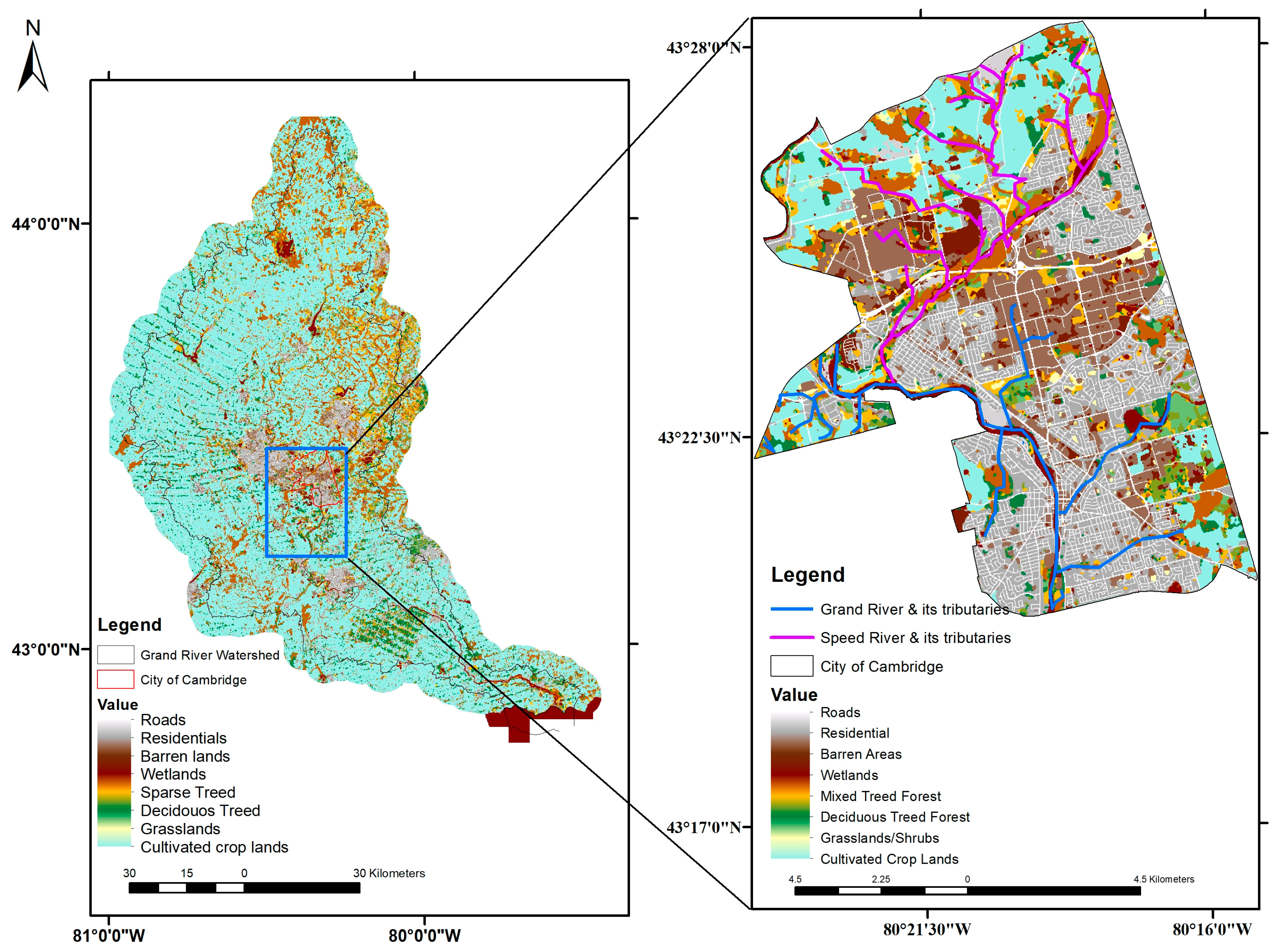
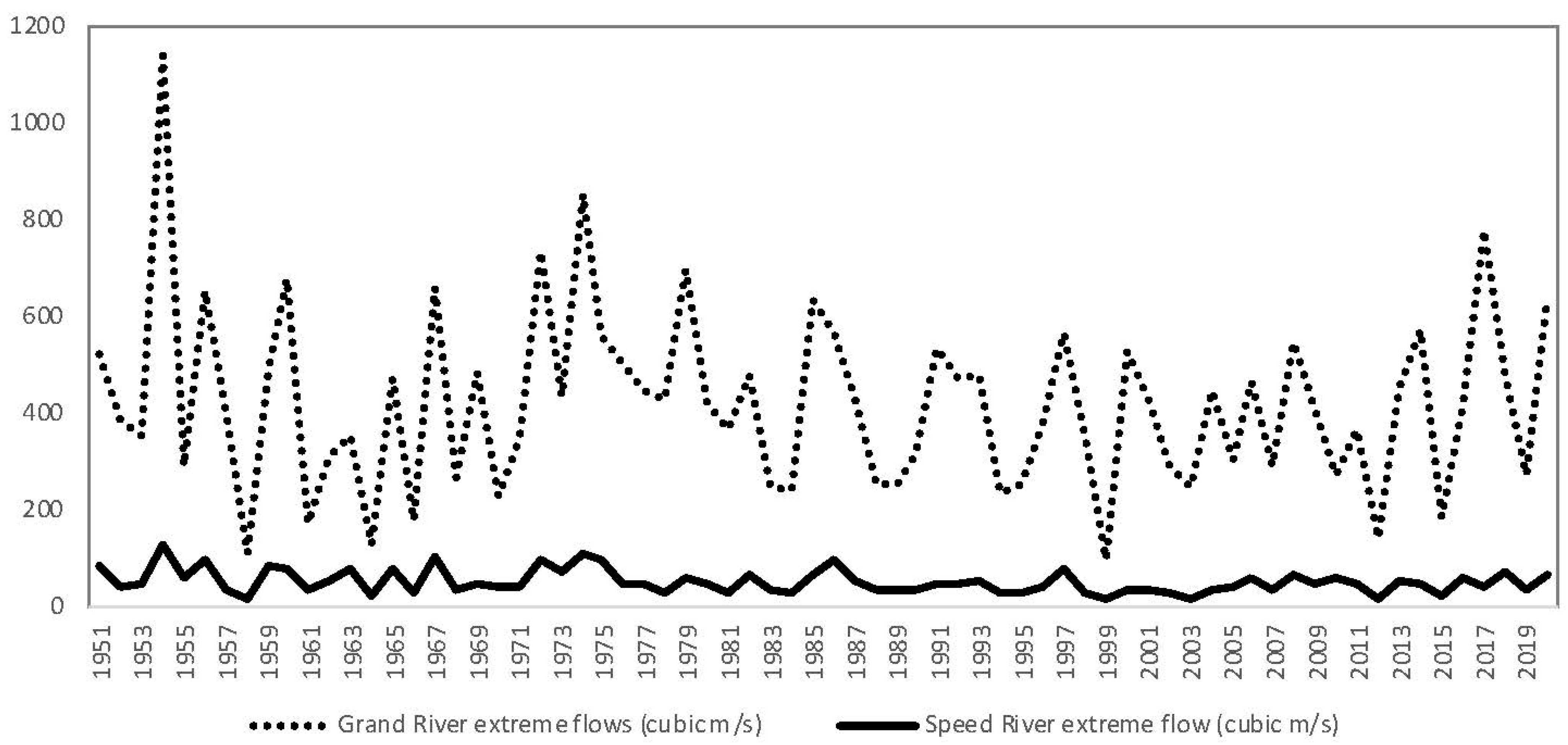
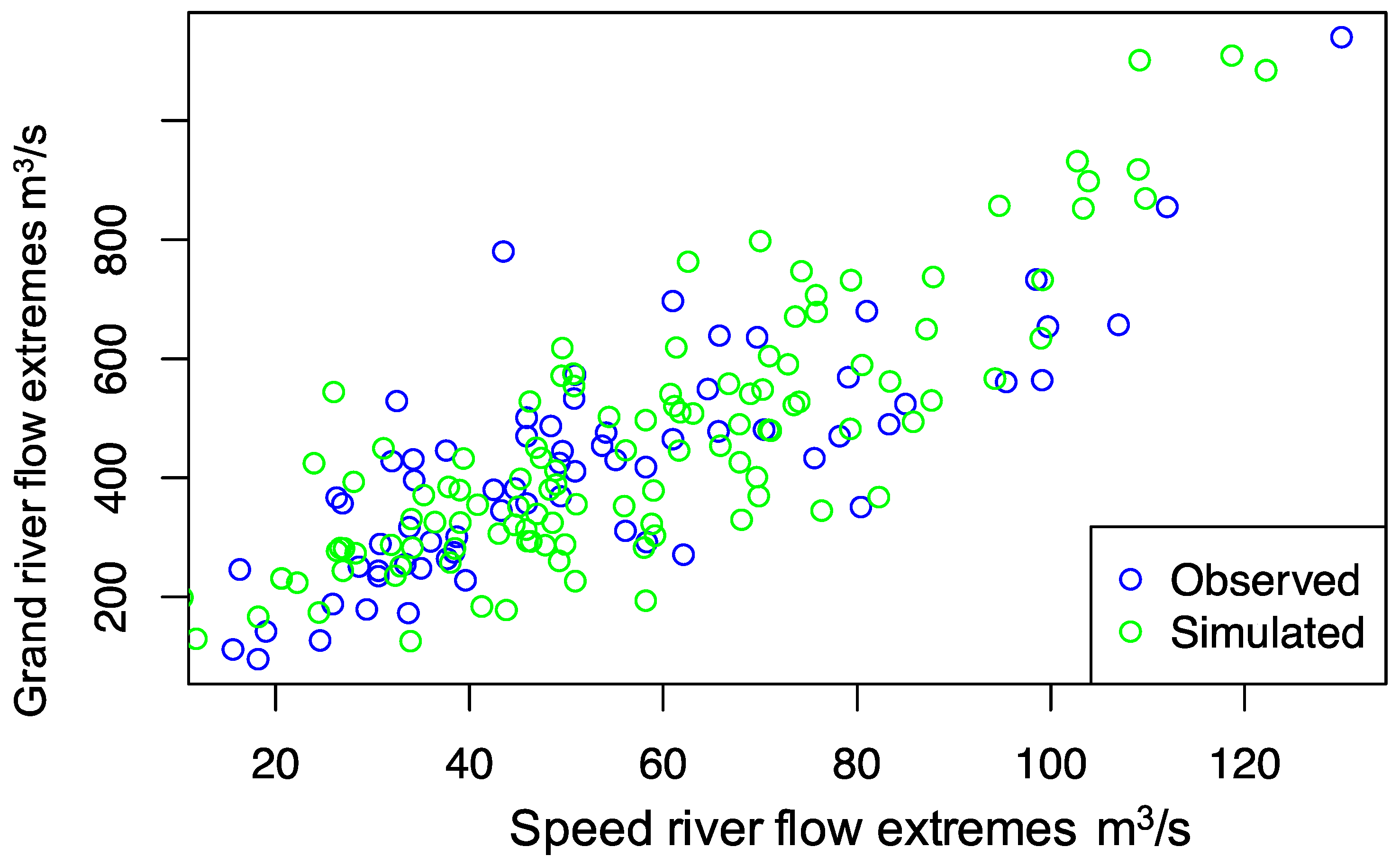
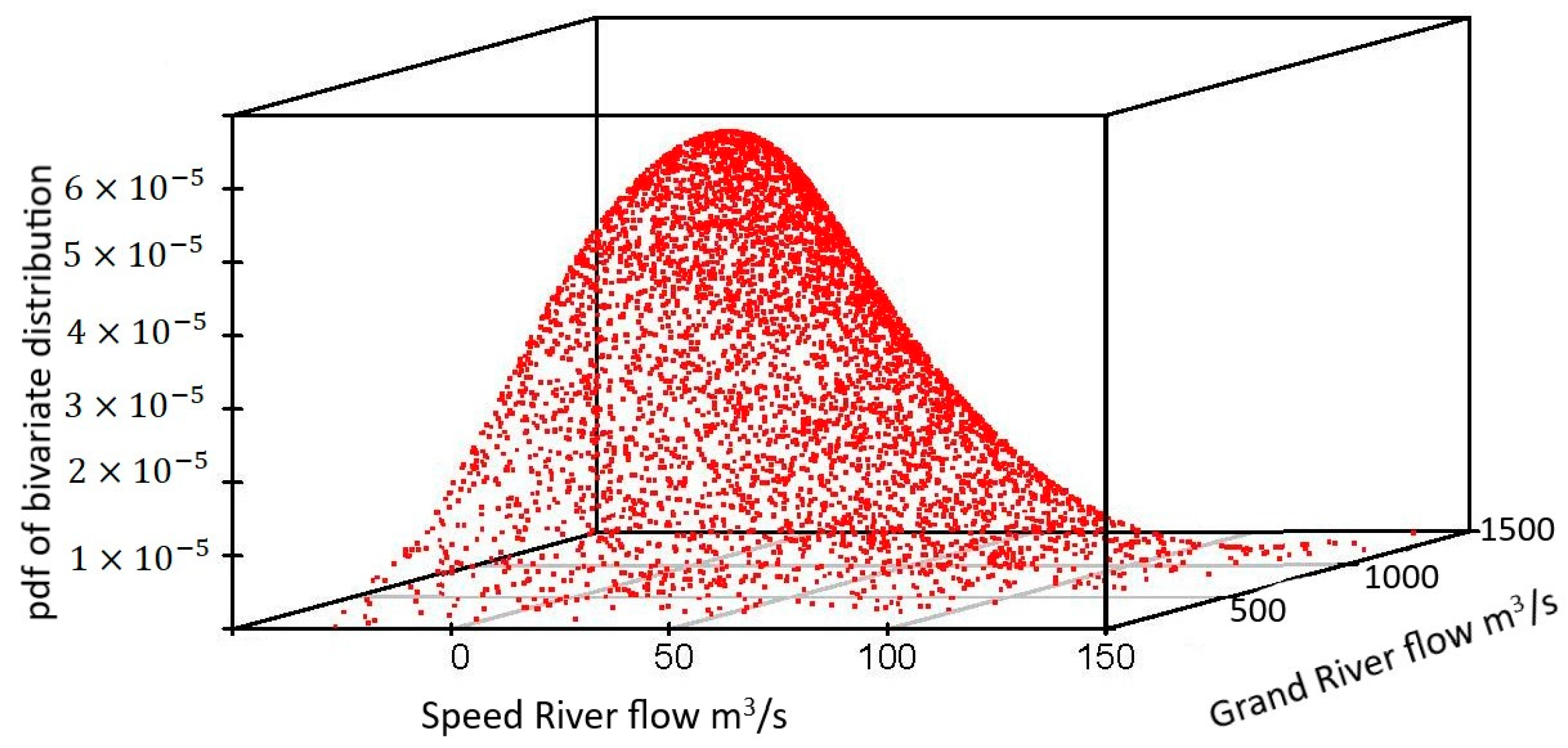

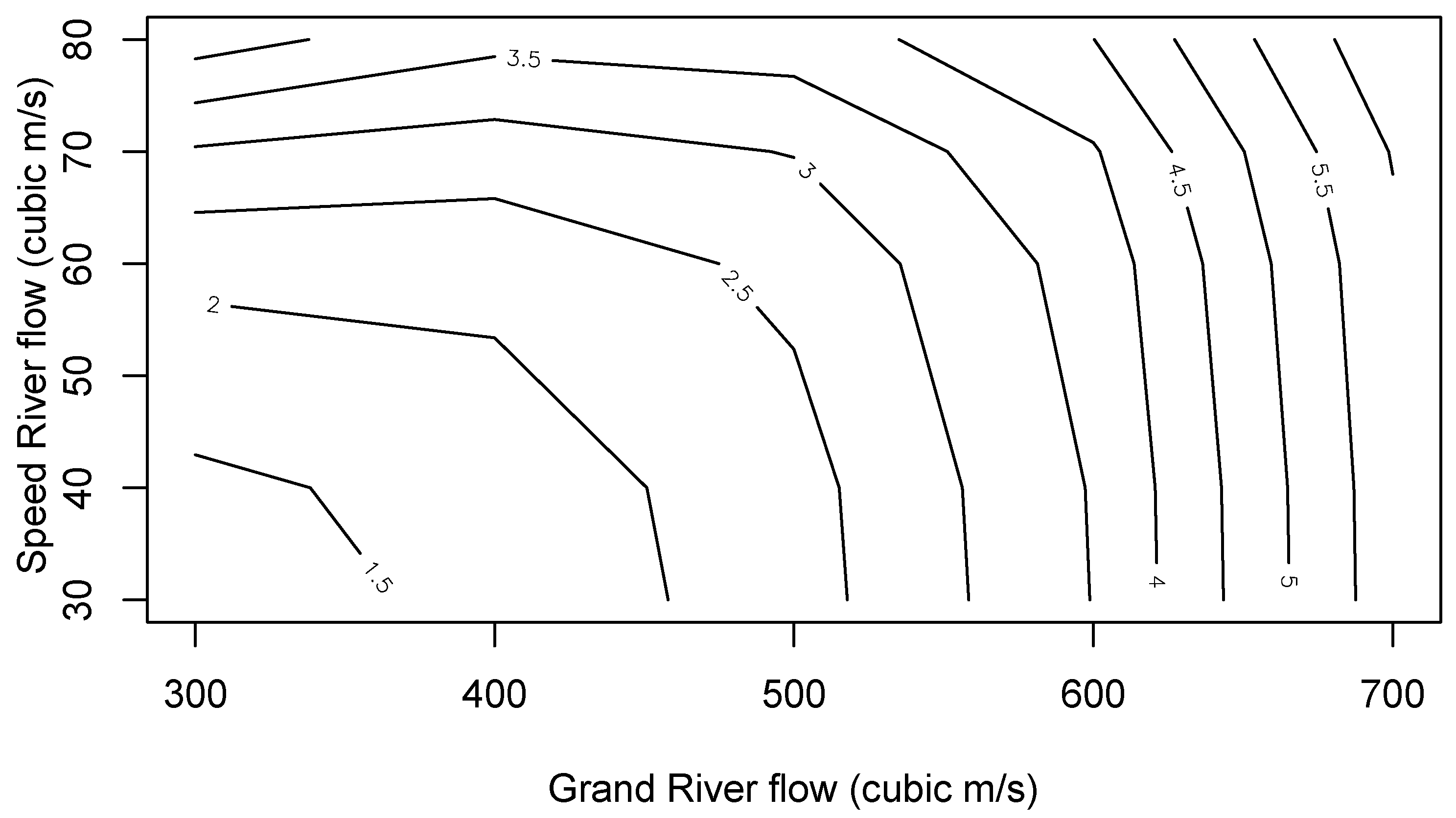

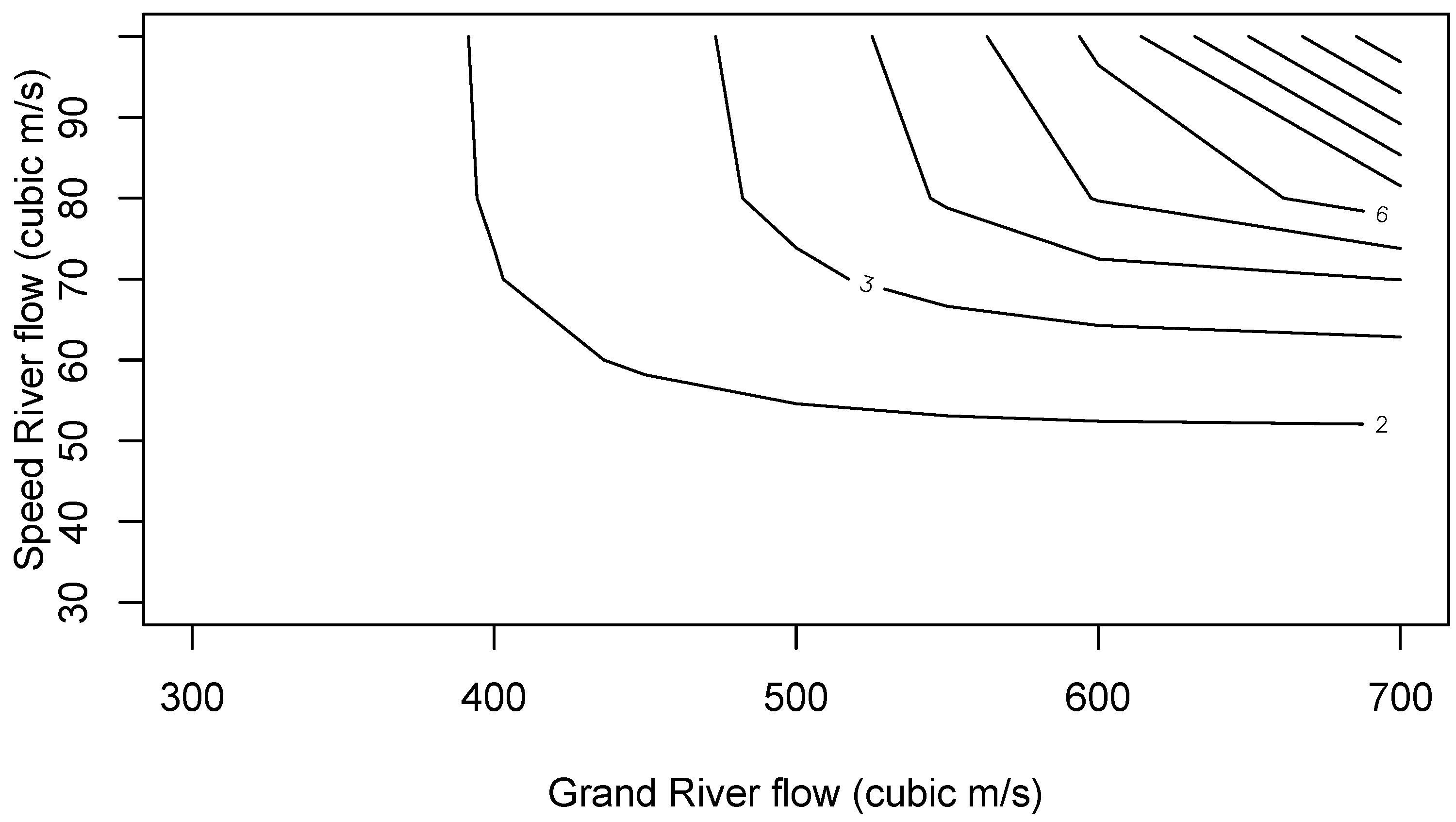
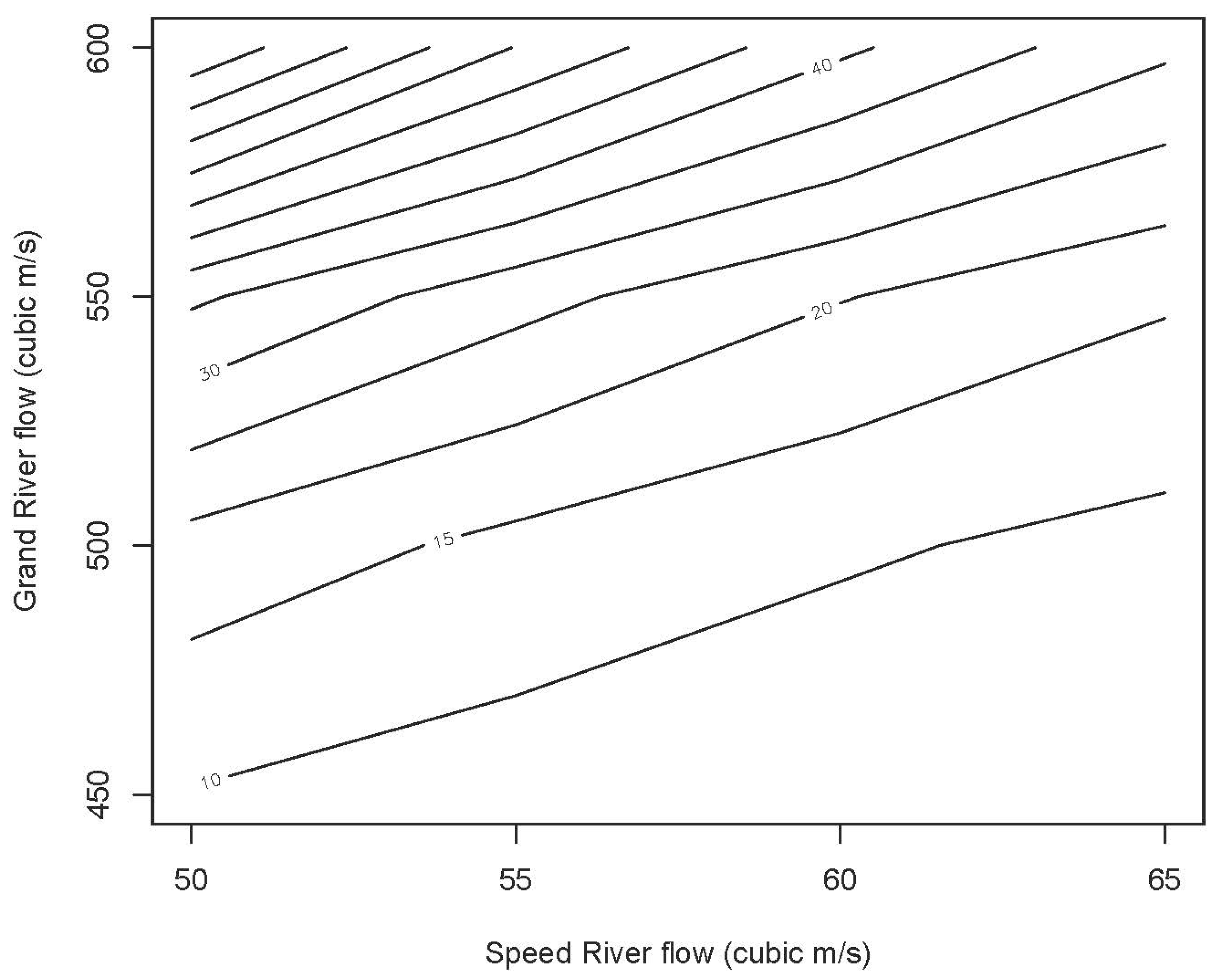

| Goodness of Fit Tests | p-Value | Test Statistic |
|---|---|---|
| Cramer-von Mises | 0.96 | 0.024 |
| Kolmogorov-Smirnov | 0.96 | 0.437 |
| Speed Flow (m3/s) | Grand Flow (m3/s) | TAND (Year) | TOR (Year) | TS (Year) | TG (Year) |
|---|---|---|---|---|---|
| 52 | 420 | 2.8 | 1.7 | 2 | 2.2 |
| 65 | 518 | 5 | 2.7 | 3.2 | 3.8 |
| 77 | 607 | 9.5 | 4.7 | 6.1 | 6.5 |
| 90 | 700 | 20.7 | 10 | 15 | 12.2 |
Disclaimer/Publisher’s Note: The statements, opinions and data contained in all publications are solely those of the individual author(s) and contributor(s) and not of MDPI and/or the editor(s). MDPI and/or the editor(s) disclaim responsibility for any injury to people or property resulting from any ideas, methods, instructions or products referred to in the content. |
© 2023 by the authors. Licensee MDPI, Basel, Switzerland. This article is an open access article distributed under the terms and conditions of the Creative Commons Attribution (CC BY) license (https://creativecommons.org/licenses/by/4.0/).
Share and Cite
Unnikrishnan, P.; Ponnambalam, K.; Agrawal, N.; Karray, F. Joint Flood Risks in the Grand River Watershed. Sustainability 2023, 15, 9203. https://doi.org/10.3390/su15129203
Unnikrishnan P, Ponnambalam K, Agrawal N, Karray F. Joint Flood Risks in the Grand River Watershed. Sustainability. 2023; 15(12):9203. https://doi.org/10.3390/su15129203
Chicago/Turabian StyleUnnikrishnan, Poornima, Kumaraswamy Ponnambalam, Nirupama Agrawal, and Fakhri Karray. 2023. "Joint Flood Risks in the Grand River Watershed" Sustainability 15, no. 12: 9203. https://doi.org/10.3390/su15129203





